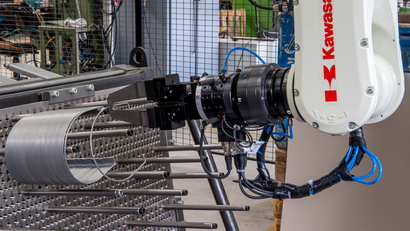Handling and end machining for wire bending parts
At Bahner und Schäfer GmbH, everything revolves around technical springs and bent parts. Competence and technical experience have been passed on there since 1931 and for more than three generations. The current generation of owners, Tabea and Matthias Schäfer, took over the company in 1994 - at that time still at the Lugau site - and has been investing annually ever since. In the current production hall, which is located at the foot of the Ore Mountains in the small town of Oelsnitz, the spring production is equipped with state-of-the-art machinery and equipment (including a modern CNC-controlled bending centre).
Despite high-tech, some things were still done by hand until recently
In the past, despite the high technological standard and level of automation in the company, some final processes were still carried out manually in the bending centre. For example, during the end processing of the bent wire parts, the product was separated from the raw wire after the bending process by means of a cutter and then fell over a chute into a large box. In order to reduce the internal stresses of the bent parts, a large part of the products had to be subjected to a subsequent heat treatment. However, a homogeneous material structure could only be achieved after the heat treatment if the parts were positioned individually in the oven. This separation of the parts as well as their positioning was carried out laboriously by hand, required a great deal of time for the worker and represented a not inconsiderable cost factor. The quality of the bent parts also suffered due to possible deformations caused by the individual workpieces becoming entangled when they were removed and separated from the crate (see photo). Another production step used to be done by hand: certain parts had to be chamfered at the edges, which had a negative impact on production costs.
Bent parts production is automated
In order to further develop the production of bent parts, Bahner und Schäfer GmbH, together with the Institut Chemnitzer Maschinen- und Anlagenbau e.V. (ICM), discussed how an automation solution could help the company to reduce costs, increase productivity and use its employees more efficiently or free them from the dreary task of manual separation. With ICM as a project partner, Bahner und Schäfer had brought in a real specialist. ICM is a private, non-profit, application-oriented research institution (industrial research institution) whose primary objective is to open up new technical and technological possibilities for SMEs. In doing so, they draw on many years of experience and a high level of competence.
The challenge for ICM was to design a system or plant that could be integrated into existing processes, was easy to operate and had acceptable amortisation costs. In addition to the pure robotics, important questions such as flexible gripper systems, supply and removal of material and energy as well as machine safety had to be clarified for a successful introduction.
Flexible robot cell and wire end processing machine as a solution
In addition to a specially designed wire end processing machine, which automatically chamfers the parts, ICM relied on a flexible robot cell for the solution for an automated separation process of the bent components. An industrial robot is now used inside a protective enclosure, which picks up the bent parts from the wire bending machine and hangs them in a defined position on a register or deposits them in a controlled manner. The hanging register serves as an intermediate station before further processing, in order to store all bent parts that can be hung up without snagging. The handling of the application consists of an XY linear axis system (2000 x 3000 mm), which is composed of a double tandem and a single axis with follower, as well as a six-axis Kawasaki robot RS010L. The axis gantry enables the robot to move on a 7th and 8th axis and thus increases its working space.
Versatile bent parts require versatile grippers
Various grippers are available to the robot for handling the diverse bent parts. The robot uses a large pool of available grippers, the so-called gripper station. Here it can select the appropriate gripper for the respective task.
ICM had selected hybrid grippers (GPP5000IL) from the gripper specialist Zimmer Group from Rheinau as gripping tools. "We needed a high gripping force, as the parts have to be held securely during the journey. In addition to a large stroke, the current position of the gripper was important for the process, for example, to detect whether the wire was gripped accurately. This is realised via the integrated measuring system. The IO-Link technology supplied was a great advantage for transferring our measurement data, such as status data, positioning data, etc. We used the tool changing system (WWR63F) from Zimmer in order to have a perspective for handling larger workpieces in the future". Marcel Ott, one of the project managers at ICM, explains his decision. Mr Ott was particularly positive about the cooperation with the Zimmer Group in terms of the extremely fast response time, the competent response, the provision of a suitable sample and, finally, the price of the grippers and their peripherals.
With an axis compensation module to success
The project managers at ICM had to overcome some challenges during the implementation of the project. In addition to the very complex assembly of the robotic cell on site, there were also small teething problems in the production itself at the beginning. For example, it turned out that the bent part or the raw wire changed its position slightly each time it was handled by the cutting process. However, since the gripper rigidly maintained its position unchanged at the moment of cutting, the workpiece had bent a little with each cut. "In order to successfully counteract this process, we mounted an axis compensation module (model AR63P) on the last axis of the robot, which is softened (pneumatically depressurised) at the moment of cutting and only returns to its usual stiffness after the complete cut through precisely timed pneumatic control of the locking piston," says Thomas Schröder - technical support & sales from gripper manufacturer Zimmer Group - describing his quick and simple solution to this problem.
The result of this entire installation is now something to be proud of: The management of Bahner und Schäfer GmbH is visibly enthusiastic and the project partner ICM is also very satisfied with its own implementation. The fast automated handling made a significant increase in productivity possible. The system is designed in such a way that the operator can set up the robot system for each new part within 15 minutes. Changeovers are possible in seconds by using recipes. Alexander Reinhold, responsible for quality assurance at Bahner and Schäfer, is impressed by the significant increase in quality in the production of bent parts.
Thanks to the machine chamfering, work can now be done even more precisely and the deformations on the bent parts caused by the snagging during manual removal from the box are a thing of the past. In addition, the monotonous activity of separating by hand is eliminated for the worker. With increased motivation, he can take on more valuable tasks in the company in the future. For Mr. Reinhold, however, the system is only the first step towards automation. Others are to follow. The next phase could be, for example, the expansion of the system so that more complex workpieces or bent parts can be processed in the future.

